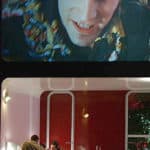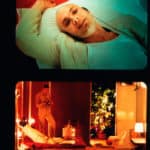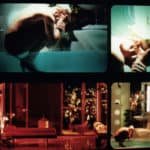Twin rooms. 2002
A show devised and directed by Enrico Casagrande and Daniela Nicolò
With Vladimir Aleksic, Renaud Chauré, Eva Geatti, Dany Greggio, Caterina Silva, Damir Todorovic
Audio Editing Enrico Casagrande
Sound Carlo Bottos
Lights Daniela Nicolò in collaboration with Luigi Biondi
Video consultancy Frederic Fasano, Massimo Salvucci, Studio Nino
Operator Barbara Fantini and Daniele Quadrelli
Stage Design Fabio Ferrini
Construction and technical management Tommaso Maltoni with Dany Greggio and Nicola Toffolini
Organisation and press office Sandra Angelini and Marco Galluzzi
Logistics Roberta Celati
A Motus and Venice Biennial Production, in collaboration with: Teatro Sanzio/Comune Administration of Urbino, Kampnagel Internationale Kulturfabrik of Hamburg, Santarcangelo dei Teatri, Infinito ltd Gallery of Torino, Xing of Bologna
With the support of Eti, Comune di Rimini, Rimini Provincial Administration, Emilia Romagna Regional Administration.
First performance Venice, Teatro Piccolo Arsenale, 9 – 10 February 2002
Twin Rooms, Motus 2002. Presentation
by Patrizia Bologna
Twin Rooms is one of the episodes of the Rooms project. The hotel room and movie set that debuted in February 2002 at the Teatro Piccolo Arsenale in Venice on the occasion of the exhibition “Temps d’Image.”
The story is taken mainly from Don DeLillo’s novel White Noise, a story that is syncopated, cut to ribbons in a display of fragments that put together suggests an elusive story that expands and contracts at the same time in multiple forms and sizes.
With Twin Rooms Motus reflects on the concept of movie fiction (as had happened in Orpheus) and initiates a phase of digital image research, adding to the specially built hotel room a second identical but totally virtual room, projected onto a screen. The two rooms – which have chamfered, rounded corners as in the best sixties style – are from any point of view the misaligned image of the same place, and foisted on the spectators, a diversified, binocular vision of the same object . The frame of this great dual screen adds another dramatic layer: the presence of a TV camera in the hands of an actor makes it possible to focus on a detail of the scene, an internal (voyeuristic), digital eye which produces a “framing” effect (whose side walls are the edges) while the spectators’ gaze, forced to follow the characters from room to room, becomes the camera’s shifting eye.
Documents are published in original language. In case the translation is present, both the original and the translation are published.
Annamaria Monteverdi, Daniela Nicolò, arteatro_interviste. Motus, «www.exibart.com», 11 June 2003.
Enrico Casagrande, Daniela Nicolò, Sulla necessità dello sguardo, «Biblioteca Teatrale», n. 74-76, Rome, Bulzoni, April-December 2005.
Tiziano Fratus, Enrico Casagrande, Daniela Nicolò, In un contemporaneo che divora. Conversazione con Enrico Casagrande, Daniela Nicolò, in Tiziano Fratus (edited by) Lo spazio aperto. Il teatro ad uso delle giovani generazioni, Editoria&Spettacolo, Rome 2002.
Daniela Nicolò, Fuori dal mondo conosciuto, in Paolo Ruffini, Ipercorpo. Spaesamenti nella creazione contemporanea, Editoria&Spettacolo, Rome 2005.
Gilberto Santini, Enrico Casagrande, Daniela Nicolò, Motus vivendi, in Gilberto Santini, Lo spettatore appassionato - appunti dal teatro del presente, Edizioni ETS, Pisa 2004.
Video where you can see the structure of the scene for the show
Twin Rooms
Short version
Antonio Caronia, Il rumore delle parole che diventano corpo, «l'Unità», 17 August 2002
"Twin Rooms", uno show d'azione e di immagini digitali, «Il Messaggero», 4 April 2003




